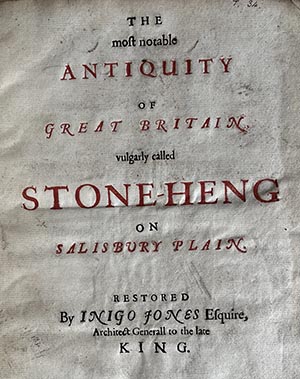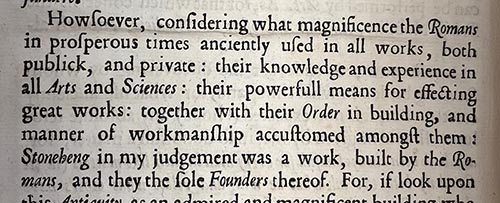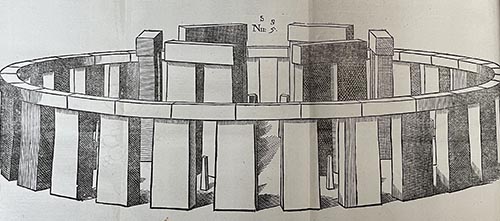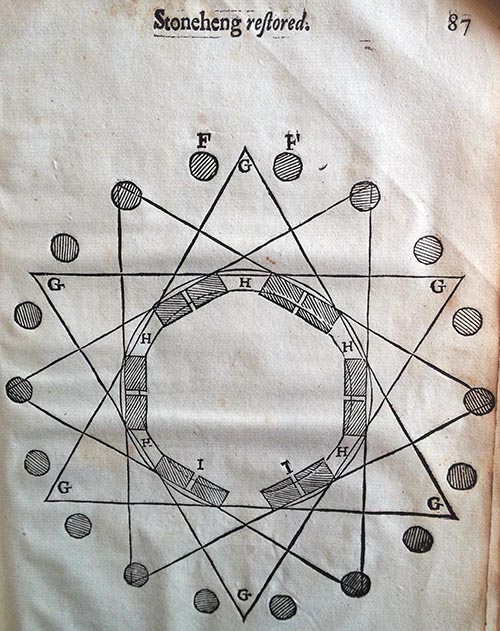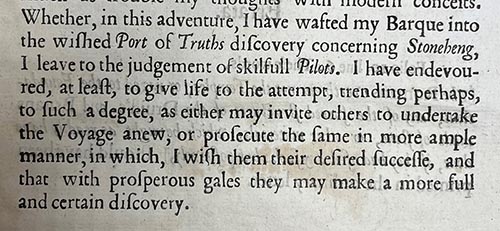Spring equinox at “vulgar” Stonehenge
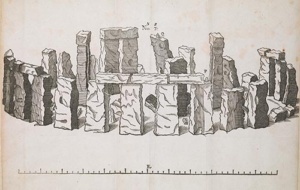
Fig.1.
In honour of the Spring equinox this week, we’re going to dive into one of the Library’s Treasures – a book about Stonehenge. At the Spring equinox, day and night are of equal length. Beyond the equinox we will see a little more daylight each day until, at the Summer solstice, the days begin to draw in towards the Winter. At sunrise on the 21st of March, people from around the country gathered at Stonehenge on the Salisbury Plain to mark the coming of astronomical Spring. After a long dark winter, it’s good to have something to celebrate!
Speculation about the people who built Stonehenge has occupied archaeologists and antiquarians for centuries. Although we now understand that the stones were erected between 3000 BC and 2000 BC, many other theories have been posited and disproved over the years. Some have claimed that Stonehenge was built by giants, or even aliens!
In 1620, James I asked Inigo Jones, the famous architect and theatre designer, to make a study of the origin and purpose of Stonehenge. After many years of deliberation, Jones concluded that, due to its ‘elegancy and proportion’, Stone-Henge was constructed not by native Britons but by the Romans. Inigo Jones was part of a group of 17th century architects who thought little of modern architecture but considered the Roman period the epitome of architectural style. It was hardly surprising, therefore, that Jones credited the Romans for building of Stonehenge. The image above (Fig.1) shows Stonehenge as it was when Jones visited in the 17th century.
When Inigo Jones died in 1652, he had not published any of his theories about Stonehenge. This curiously titled book was published in London in 1655. Although the title page of this volume (Fig.2) states that it was written by Inigo Jones, it seems more likely that Jones’ pupil, John Webb wrote the text with the help of ‘some few indigested notes’ that Jones left behind. Perhaps giving a hint as to the real author of the work, the dedication is signed not by Jones, but by Webb. There are twelve illustrated plates, some of which fold out to show a larger view of the stones. Despite his prolific career, this is the only one of Jones’ works to have been published. As the work is presented as if written by Jones rather than Webb, for simplicity’s sake we shall refer to Jones as the author.
Inigo Jones’ claim that the Romans built Stonehenge rested in part on his low opinion of the British in ancient times. He argued that a people who were unable even to clothe themselves would not have been able to build such a ‘stately’ structure as Stonehenge (Fig.3).
Inigo Jones, who first travelled to Italy when he was in his twenties, became a devotee of Italian culture. The Romans, according to Jones, were much more sophisticated, with a superior knowledge of the Arts and Sciences. The Egyptians, ‘Eastern nations’, and the Greeks he dismissed as never having built anything displaying the skills demonstrated in Stonehenge. Jones cites several reasons that the Romans were the most likely builders, with their use of mathematics and order in architecture chief amongst them (Fig.4).
The illustration below (Fig.5) is one of the fold-out leaves showing “the whole work in Prospective, as when entire, whereby the general composure of the particular parts of the uprights, are together all seen: and, by which also, the stately aspect, and magnificent greatnesse thereof, are fully, and more apparently conspicuous.” Figure 6 illustrates how the structure of Stonehenge was, according to Jones, based on four superimposed equilateral triangles inscribed in a circle. Jones, ever the Italophile, attributed this mathematically structured architecture to the Romans.
After over 100 pages of justification for his belief that the Romans built Stonehenge, Jones ends on a curious note (Fig.7). This elegant little disclaimer invites others to come up with other theories about the origins of Stonehenge. As it happened, only eight years after Jones’ work was published, Dr Walter Charleton took up the challenge and published a treatise claiming that it was, in fact, the Danes who built Stonehenge. Modern research methods have revealed a great deal more than Jones knew about how, why, and by whom Stonehenge was built, but the site remains a place of pilgrimage to people wanting to celebrate the Spring equinox.
Bibliography
P.35.11 Inigo Jones: The most notable antiquity of Great Britain, vulgarly called Stone-Heng on Salisbury plain (London: 1655).
References
English Heritage website: History and Stories: Stonehenge | English Heritage (english-heritage.org.uk)
Newman, J. Jones, Inigo (1573–1652), architect and theatre designer. Oxford Dictionary of National Biography. Retrieved 21 Mar. 2023, from oxforddnb.com
Published: 22 March 2023
Further selected Univ Treasures are detailed below or explore the whole collection on our News and Features Treasures pages.

